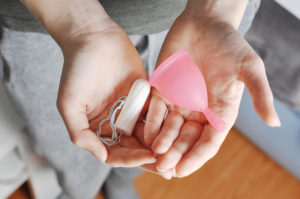Menstrual Cup Benefits
A lesser known alternative to sanitary pads and tampons, the menstrual cup is another device menstruating individuals can utilize. Though it can be found in all major pharmacies and the oldest ads for it date back to the 1930s, the menstrual cup has only recently begun gaining popularity with women.
Shaped like a bell, menstrual cups are usually made of silicone, rubber, or latex. A menstrual cup is inserted into the vagina during your period to collect menstrual blood and fluids in its receptacle. In contrast to tampons and pads, which are absorbent, you have to empty out the reusable cup when it is full.
Advantages
Menstrual cups are relatively easy to clean, as they need to be rinsed off with warm water between uses during menstruation and washed off with warm water and soap between periods. They should be stored in breathable containers, such as a cloth bag.
A cup usually becomes full in 4-6 hours, but that may depend on the flow of one’s period—menstrual cups can be used for up to 12 hours before they need to be emptied out, which makes them more durable and less expensive than other methods. This is in addition to their reduced landfill, since the life length of one cup is around 10 years.
Menstrual cups stay in place and gather the fluids with suction, which makes the possibility of leakage and unpleasant odors significantly less than if using other methods. Because they are non-absorbent, the danger of menstrual cups negatively affecting the pH of the vaginal area or creating an environment friendly to bacteria is actually less in comparison with absorbent, cotton-based methods.
Disadvantages
Though all in all a more financially and environmentally smart solution than tampons and pads, menstrual cups do come with some challenges.
The most significant concerns raised have to do with the insertion and placement of the cup: it needs to be inserted into the vagina so that it’s at a 45 degree angle, thus giving it the correct shape to collect the blood. This requires some practice, especially since the cup needs to be turned once in the vagina to suction on the vaginal walls correctly and to not become displaced. Some women may not be comfortable placing the cup, nor do they receive clear instructions on how to do so effectively. Incorrect placement of the cup can make it uncomfortable to wear or result in leakages and more mess than necessary. Other possible fit problems may be presented depending on each person’s anatomy; each body is different, and some may find a cup simply does not fit them.
Another disadvantage of the cup concerns its removal, as it can be tricky: the cup should not be pulled, but its bottom should be pinched to make it thinner, cease the suction, and safely remove it from the vagina, while emptying out its contents in the toilet bowl.
Takeaway
As is the case with every available method, menstrual cups will be a better solution for some people than they will be for others. Overall, this device does not seem to be presenting as many health concerns as absorbent methods, but it does have a higher “ick” factor that may make some uncomfortable, or even cause embarrassment.

